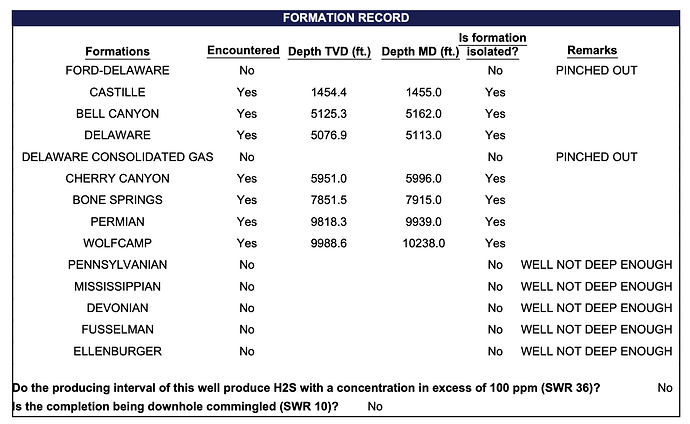I was browsing the RRC’s documents for one of the wells in which I own interest and I have a question about the Formation section.
-
What does “Pinched out” mean?
-
Because the well encountered various formations (Castille, Bell Canyon, Delaware, Cherry Canyon, Bone Springs, Permian, and Wolfcamp), does this mean that they can drill directly into all of these formations from this wellbore? Or do they need to drill separate wells into each formation? I’m not really clear on how the parent/child wells work in stacked plays.
-
Along these same lines, how do you determine that a well is a parent or child well?
In short, “pinched out” means the formation was not present in that particular well bore when they thought it would be.
They will not drill into separate formations from the same wellbore unless the horizontal drillbit deviates some into an adjoining formation when drilling “sideways”. In other words, the drillbit might deviate up or down while in the intended formation and come in contact with an adjoining formation.
The “parent” well is the first well in a unit drilled into a reservoir (formation). Any additional wells in that same reservoir are “child” wells.
Hope this helps.
Todd M. Baker
Thanks. How do you determine if a specific well is a parent or child well?
RRC requires the operator to report the depths where various formations were encountered as well was drilled to its total vertical depth (TVD). The operator has to drill through the shallow formations to reach its targeted depth. Each number of feet is the top of that formation and does not tell you the depth of the base of the formation. A formation is not flat, but ‘waves’ up and down underground and so the depth will vary even within a section. The MD is based on the length of the wellbore including the curve. For the shallow formations, the wellbore is fairly straight, but you can see the difference due to the curve as it gets to the Wolfcamp target zone. Theoretically, once the Wolfcamp production ceases, the operator could recomplete the well up-hole in a shallow zone, such as the Cherry Canyon.
2 Likes
Hello Danna. To determine a parent/child, you can look a the completion dates if you can find them. If you can’t find those then look for the first production date. The well with the earlier completion date or first production date would be the parent well. You also want to limit the search radius of any particular well to about a half-mile when checking for parents and children. It’s possible to have communication between some geological formations but you could also consider only looking at wells within the same formation for possible interference - especially in the Permian where the formations are usually pretty thick.
Keep in mind that a well could be both a parent and a child. In this case there could be a producing well nearby when the well was completed and then another well could be completed nearby afterwards.
There are a lot of other scenarios to think about but if you give me a particular well I could look it up and give my thoughts on parent/child relationships for that well.
